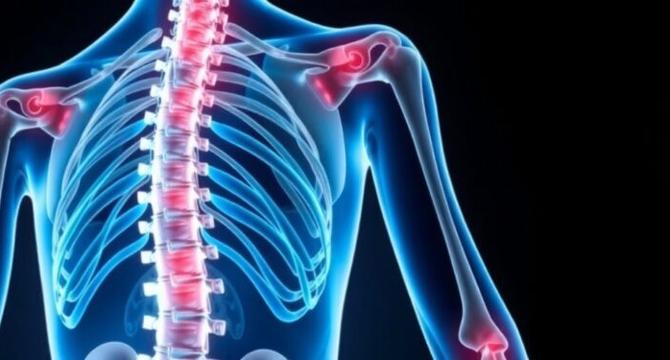Bio News
Bioengineer
146

Image Credit: Bioengineer
Nicotinamide mononucleotide (NMN) as an anti-aging health product
- Nicotinamide Mononucleotide (NMN) has emerged as a beacon of hope in the quest for longevity, capturing the attention of both consumers and scientists.
- NAD+ levels decline with aging leading to reduced mitochondrial energy production, oxidative stress, DNA damage, and cognitive impairments collectively referred to as age-related complications.
- NMN, a precursor to NAD+, has demonstrated potential to mitigate these age-related complications by replenishing NAD+ levels.
- Animal studies have elucidated NMN's ability to enhance mitochondrial function, reduce inflammation, and improve insulin sensitivity.
- Early clinical studies have reported promising results regarding NMN’s bioavailability and short-term safety, but concerns remain around high-dose administration and long-term implications.
- NMN's therapeutic potential spans a wide array of conditions, including mitigating Alzheimer’s pathology, restoring mitochondrial bioenergetics, and reducing oxidative stress.
- The absence of stringent approval processes exposes consumers to unverified claims and prompts calls for stricter standards to ensure the safety and efficacy of NMN products.
- Emerging evidence suggests that NMN’s effectiveness is mediated through its impact on sirtuin activity, mitochondrial function, and oxidative stress regulation.
- While NMN’s pharmacological benefits are promising, its safety profile warrants thorough investigation.
- The scientific community’s consensus emphasizes the urgent need for rigorous clinical trials to evaluate NMN’s efficacy and safety.
Read Full Article
8 Likes
Bioengineer
137

Image Credit: Bioengineer
The Impact of Gender on Sleep Development
- Girls exhibit advanced inter-hemispheric fiber development and higher cortical function maturation rates compared to boys, which may explain differences in sleep physiology and duration.
- Girls tend to sleep longer with less fragmentation compared to boys through infancy to adolescence, manifesting early and persisting through developmental stages and may stem from biological factors.
- Adolescent girls face unique stressors, which can disrupt sleep, making them report higher rates of insomnia symptoms compared to boys, and may stem from stress reactivity, emotional processing, and fluctuating ovarian hormone levels.
- Sleep disorders, including insomnia, show clear sex-related prevalence patterns. Recent studies highlight that boys are more prone to non-rapid eye movement (NREM) parasomnias in childhood, whereas adolescent girls are more susceptible to insomnia.
- Oestradiol, a key female sex hormone, impacts sleep architecture by promoting sleep stability and influencing the brain regions associated with sleep regulation. Conversely, testosterone appears to have a negligible impact on sleep patterns.
- Sleep and cognitive development intersect in gender-specific ways, as girls tend to outperform boys in language-related tasks, reflecting their higher levels of slow-wave activity (SWA) in cortical regions associated with language processing. Boys, on the other hand, excel in spatial tasks, indicative of the different areas of the brain activated during sleep.
- Addressing sleep disparities requires a multifaceted approach. Schools, families, and healthcare providers must work together to create environments that support healthy sleep habits. For adolescents, interventions should be tailored to their developmental stage, taking into account the hormonal and psychosocial factors that influence sleep.
- Future research should focus on the mechanisms underlying these differences, particularly the role of sex hormones and their interaction with environmental factors. Longitudinal studies tracking sleep patterns from infancy to adulthood could provide valuable insights into how these differences evolve and how they can be addressed.
- From infancy through to adulthood, girls consistently exhibit longer, higher-quality sleep than boys, a difference rooted in both biology and the environment. These patterns have profound implications for cognitive development, emotional well-being, and overall health.
- Recognizing and addressing sex and gender differences in sleep may promote better sleep health and improve the quality of life for individuals across all stages of development.
Read Full Article
8 Likes
Bioengineer
8

Image Credit: Bioengineer
Scientists Develop Bacteria-Repellent Surfaces That Promote Cell Growth
- Researchers from Tokyo Metropolitan University have developed nanostructured alumina surfaces that are highly antibacterial and can be used for cell culture.
- The nanostructured surfaces resist bacterial growth and do not interfere with cell cultures, making them ideal for regenerative medicine.
- These surfaces have been prepared using electrochemistry in concentrated sulfuric acid and show unprecedented resistance to bacterial contamination.
- The technology offers a sustainable alternative to antibiotics for producing high-quality cell cultures without bacterial contamination.
Read Full Article
Like
Bioengineer
34

Image Credit: Bioengineer
Scientists Develop Bacteria-Resistant Substrates That Promote Cell Growth
- Scientists at Tokyo Metropolitan University have developed anodic porous alumina (APA) surfaces with extraordinary antibacterial properties that also promote cell growth.
- The nanostructured surfaces disrupt bacterial cell walls, preventing bacterial growth while enabling the safe proliferation of mammalian cells.
- The APA surfaces offer a safer alternative to antibiotics in cell culture and regenerative medicine applications, reducing the risk of antibiotic resistance.
- The ease of manufacture and potential for widespread adoption make these surfaces valuable for creating sterile environments in laboratories and hospitals.
Read Full Article
2 Likes
Discover more
Bioengineer
215

Image Credit: Bioengineer
Promising New Tablet Offers Hope for Controlling and Eradicating Intestinal Worms
- A clinical trial led by the Barcelona Institute of Global Health in collaboration with the STOP consortium has resulted in a significant breakthrough in the treatment of soil-transmitted helminthiases.
- The clinical trial introduced a tablet that combines albendazole and ivermectin, which is not only safe but is also more effective than the current standard treatment with albendazole alone, particularly in combating infections caused by Trichuris trichiura and other soil-transmitted helminths.
- Soil-transmitted helminthiases are parasitic infections caused by four major species of worms transmitted through contaminated soil and water, posing a considerable risk in Latin America, Asia, and sub-Saharan Africa.
- Albendazole has proven effective against Ascaris lumbricoides, but its efficacy against T. trichiura and S. stercoralis appears to be waning, potentially due to the emergence of drug resistance.
- The STOP consortium embarked on a ground-breaking clinical trial, funded by the European and Developing Countries Clinical Trials Partnership which aimed to evaluate a fixed-dose combination tablet containing both albendazole and ivermectin.
- The trial involved school-aged children diagnosed with T. trichiura, hookworms, or S. stercoralis and aimed to provide robust data on the safety and efficacy of the new treatment approach.
- The results of the trial revealed promising outcomes regarding efficacy, particularly against T. trichiura and hookworms. The fixed-dose combination achieved remarkable cure rates and showcased the superior efficacy of the fixed-dose combination when aligned with current treatment practices.
- The implications of this research extend far beyond a single trial, as they could pave the way for re-evaluating current elimination goals for STH and reshape public health policies on these neglected diseases that have long been regarded with a sense of inevitability in endemic regions.
- The innovative design of the Co-formulation focuses on easy administration, a critical characteristic for mass deworming campaigns aimed at vulnerable populations.
- The findings from the clinical trial point to a promising future in the fight against soil-transmitted helminthiases, highlighting the potential for a more effective and comprehensive approach to combating these neglected tropical diseases.
Read Full Article
12 Likes
Bioengineer
38

Image Credit: Bioengineer
New Treatment for Widespread Parasitic Infections: Phase II-III Trial Demonstrates Safety and Enhanced Efficacy
- Researchers have achieved promising results with a new drug combination for reducing the global burden of intestinal parasites, according to a Phase II-III clinical trial.
- The study focuses on a co-formulation of two antiparasitic agents, albendazole and ivermectin, designed for treating soil-transmitted diseases.
- The trial's rigorous methodology ensured that data collected was robust and reliable by set inclusion and exclusion criteria.
- In developing countries where health care infrastructure may not always support comprehensive treatment regimens, this treatment is particularly relevant.
- The co-formulation's potential for aligning with the World Health Organization's goals underscores a commitment to achieving significant milestones in the eradication of neglected tropical diseases.
- The publication of the trial in a world-renowned journal further validates the credibility of the findings and opens avenues for discussion within the scientific community.
- The anticipated release of this study's results is palpable within the healthcare sector, stakeholders eagerly awaiting insights.
- The progression from clinical trial findings to implementation in clinical practice is imperative, requiring a concerted commitment from various sectors of society.
- The new treatment could reduce the overall prevalence of soil-transmitted helminth infections and lower morbidity levels disproportionately affecting children and low-income communities.
- Successful treatment strategies can potentially lead to transformative changes in patient care paradigms, ensuring the overall well-being of affected communities.
Read Full Article
2 Likes
Bioengineer
366

Image Credit: Bioengineer
UTHealth Houston Secures $2.9M Grant to Revamp Clinical Trials for Neurological Disorders in Underserved Communities
- UTHealth Houston has secured a grant of $2.9m from the NIH to enhance inclusivity and effectiveness of clinical trials for neurological conditions affecting underserved populations. The grant aims to address disparities in neurological outcomes, such as stroke, Parkinson’s disease, and vascular cognitive impairment, along with dementia. Researchers will prioritize community input from the outset, ensure research findings are reflective of a broader patient demographic and establish the framework for research interventions. The initiative aims to conduct research that offers educational resources, emphasising prevention and treatment.
- The Brain Health Equity Collaborative, facilitated by partnerships between academic institutions and community organisations, is one of the key components of the initiative, promoting the inclusivity of future clinical trials. Co-investigators in this project are experts in neurology and biostatistics, committed to ensuring the perspectives of underserved communities are prioritised in the research process.
- Logistical barriers often hinder participation from lower-income populations. Clinical trials traditionally require participants to attend in-person consultations during standard work hours, which can be a significant barrier to individuals who may forfeit wages as a result. Telemedicine will be deployed to allow participants to engage in follow-up visits remotely, alleviating the burden of travel and time off work.
- This funding underscores the government’s commitment to advancing health equity within clinical research. Fund recipients are challenged to reconsider longstanding paradigms to improve participation rates in clinical trials and offer accessible educational resources.
- In addition to increasing participation in research, the infrastructure being built through this program seeks to empower communities by offering educational resources that foster a better understanding of neurological conditions, emphasizing prevention, risk factors, and available treatment options.
- Through collaborative efforts and a steadfast commitment to equity, UTHealth Houston is nurturing a transformative paradigm that brings together science and social equity to create a healthier future for all populations. This project has the potential to alter the landscape of neurological research, creating a model that could be used in other areas of medicine where disparities persist.
- The outcomes of this project may determine how future research is framed and conducted, setting an example in prioritizing community engagement, inclusivity, and social responsibility within the realm of clinical trials.
- The initiative's approach will prioritize community input from the outset, ensure research findings are reflective of a broader patient demographic and establish the framework for research interventions that offers educational resources, emphasising prevention and treatment.
- By addressing the inherent biases in clinical research, UTHealth is setting a precedent that other institutions may follow, leading to change in the standard clinical trial process.
- The potential for this project to alter the landscape of neurological research is profound, creating a model that could be replicated in other areas of medicine, where disparities persist.
Read Full Article
22 Likes
Bioengineer
194

Image Credit: Bioengineer
Accelerating Personalized Depression Treatment: Unlocking the Best Approaches for Individuals
- PEARLDIVER project is a collaborative endeavor by six European university medical centers to fast-track research into established and novel depression treatments. The goal is to develop standardized evidence-based approaches that can lead to improved clinical outcomes. The project embraces a novel platform study methodology that enables multiple treatments to be assessed simultaneously, increasing efficiency and reducing redundancy.
- The PEARLDIVER initiative seeks to construct a robust European-wide research infrastructure over the next four years prioritizing rigorous scientific standards. The project aims to transform the framework of mental health clinical trials by directly involving patients in the study design.
- With the ability to review numerous interventions in parallel, studies can operate with increased agility, reducing the burden on participants and dynamic responses to new findings. The innovative approach of platform study brings fundamental changes to how treatment effectiveness is evaluated.
- PEARLDIVER project aims to identify which therapies hold the most promise for specific patients in a timely manner and also streamlines participant enrollment processes. By addressing the specific needs of patients and leveraging an innovative, collaborative research framework, PEARLDIVER is poised to pave the way for breakthroughs in depression treatment.
- The outcomes of PEARLDIVER could have far-reaching implications, establishing a precedent for how mental health treatments are developed and tested. In conclusion, the establishment of the PEARLDIVER project represents a significant milestone in the collective efforts to tackle the pressing challenges posed by depression.
- PEARLDIVER is a collaborative research project aimed at developing effective therapies for depression. Traditional clinical trials often fall short in providing reliable conclusions for clinical practice resulting in several approved depressive treatments that do not provide sustained relief. PEARLDIVER is an innovative effort that makes use of the platform study methodology to streamline clinical trials and develop methodologies for personalized depression treatment.
- PEARLDIVER is a consortium of six prominent European university medical centers that prioritizes rigorous scientific standards and aims to construct a robust European-wide research infrastructure over the next four years. The initiative then plans to assess the safety and efficacy of innovative medications in ensuring that treatments evolve according to the lived experiences of those affected by mental health challenges.
- PEARLDIVER incorporates patient feedback and insights to transform the framework of mental health clinical trials. The project aims to identify personalized interventions that have the highest chances of providing sustained relief to patients.
- PEARLDIVER uses a platform study approach that enables multiple treatments to be assessed simultaneously, allowing for increased agility, reduced redundancy, and dynamic responses to new findings. The innovative approach of platform study brings fundamental changes to how treatment effectiveness is evaluated.
- PEARLDIVER is an innovative effort to develop personalized depression treatment. The project is poised to pave the way for breakthroughs in depression treatment by paving the way for how mental health treatments are developed and tested.
- PEARLDIVER is an exciting research collaboration project between leading European medical institutions that prioritizes patient perspectives, shared research infrastructure, and an unwavering commitment to evidence-based practices.
Read Full Article
11 Likes
Bioengineer
107

Image Credit: Bioengineer
New Study Investigates Bone Health in Women Aged 60 and Above
- The Hinda and Arthur Marcus Institute for Aging Research at Hebrew SeniorLife has initiated a clinical food trial that aims to explore the efficacy of a unique combination of probiotics and prebiotics, known as Bondia or SBD111, in promoting bone health among women aged 60 years and older.
- The trial will assess whether synbiotic blend can influence metabolic processes that are critical to maintaining healthy bone density in older adults.
- Osteoporosis is a silent condition that often goes undiagnosed until a fracture occurs, leaving many older adults vulnerable to serious health complications.
- The STARS trial is set to provide invaluable data on the feasibility and effectiveness of synbiotics in combating osteopenia and osteoporosis.
- With rigorous methodology in place, the research aims to establish a clear link between the intake of these beneficial compounds and improvements in bone health metrics.
- As the study progresses, every participant’s contribution will be crucial in shaping a framework that could potentially shift paradigms in how bone health is approached in aging populations.
- The collaboration between the Marcus Institute and various esteemed institutions highlights a collective commitment to advancing gerontological research.
- As the study unfolds and data are collected, the medical community will be keenly observing how this innovative strategy could redefine approaches to preventive care for older adults.
- Ultimately, the study exemplifies the potential for groundbreaking dietary interventions to revolutionize health care methodologies aimed at older populations.
- The commitment to understanding the mechanisms of aging through research such as this one offers the promise of a brighter, healthier future for generations to come.
Read Full Article
6 Likes
Bioengineer
388

Image Credit: Bioengineer
Leveraging AI to Identify Long COVID Care Requirements for Hospital Patients
- Researchers from the Perelman School of Medicine at the University of Pennsylvania have shown how machine learning algorithms can identify patient cohorts that reflect the specific needs of local populations.
- The team looked at electronic health records from eight pediatric hospitals to identify the post-acute healthcare demands of long-COVID cases.
- Their findings reveal the heterogeneity present in patient populations and creates a roadmap for other hospitals to follow.
- Latent transfer learning is a sophisticated machine learning technique, and by using this system, researchers identified four distinct sub-populations of long-COVID patients.
- The researchers stressed the importance of targeting interventions effectively in response to the specific needs of different patient groups.
- The research underscores the potential gap in care that exists when hospitals adopt a standardized, one-size-fits-all approach to treatment, and a nuanced approach based on patient population needs is more important.
- Sharing data among hospitals is essential for AI-driven systems, according to lead author Qiong Wu.
- Collaboration among institutions is vital in the healthcare sector, and sharing the best practices and insights gleaned from data analysis can result in better patient outcomes across the board.
- The insights from the study pave the way for future innovations that prioritize patient well-being and enhance clinical efficacy, creating an era of personalized care.
- The use of AI in healthcare settings has the potential to revolutionize healthcare delivery by providing more efficient and effective care.
Read Full Article
23 Likes
Bioengineer
51

Image Credit: Bioengineer
New Research Uncovers Surprising Source of Winter Ozone Pollution
- Researchers from the Hong Kong Polytechnic University uncovered ozone pollution in Chinese city Lanzhou during winter months. Severe ozone pollution is usually associated with high temperatures and abundant sunlight, but hourly levels in China were found to exceed 100 parts per billion by volume during colder months. Study results showed that alkene emissions from petrochemical industries are primarily responsible. The study could impact upon public health and environmental policy, indicating a need for a wider range of strategies aimed at controlling alkene emissions and implementing real-time monitoring systems for air quality fluctuations to better implement interventions.
- The research team used photochemical box models to evaluate conditions leading to elevated ozone levels and identified specific alkene species as significant contributors to the observed pollution. Regulations may now target petrochemical industries responsible for alkene outputs, while overall reduction of alkene emissions by around 28.6%, or nitrogen oxides of about 27.7% during early afternoon hours, could lead to drastic reductions in ozone concentrations. The study serves as a call to environmental regulators, urban planners, and public health officials to address air pollution proactively.
- The study also implies the need for interdisciplinary collaboration between scientific communities, policymakers, and industries for real-time monitoring of atmospheric fluctuations and implementation of timely interventions geared towards comprehensive measures adopting a wide range of salts and chemical processes that are benign to the environment.
- This research illustrates the urgent need for mitigation to consider the complexities and subtleties intrinsic to chemical interactions and emissions in the atmosphere for healthy and resilient city living in a changing planet.
- The findings highlight the intricate chemistry of the atmosphere and how it generates ozone during frigid periods, which challenges previous expectations that tied ozone pollution exclusively to summertime heat and sunlight.
- Such unexpected phenomena coincide with climate change and increased concerns about the effects on chemical reactions in the atmosphere. This underscores the need for ongoing research.
- The study emphasizes that severe air quality issues can emerge in situations conventionally believed to be less conducive to such pollution.
- Acknowledging the potential for winter ozone pollution encourages a comprehensive approach that includes both mitigation strategies and advanced public awareness campaigns about the complexities of air quality.
- The study also highlights our essential responsibility towards the environment as societies continue to industrialize and urbanize.
- This study is pivotal, prompting a reassessment of strategies towards air quality management and public policy. It advocates for a proactive approach to industrial emissions, particularly compounds like alkenes that are often overlooked.
Read Full Article
3 Likes
Bioengineer
43

Image Credit: Bioengineer
Nature’s Ally: The Natural Antagonist to Hazardous Bacterial Biofilms
- Researchers at the University of California, Riverside, have uncovered the inhibitory effects of the plant metabolite named MEcPP on biofilm formation in E. coli and other bacteria.
- Biofilms pose considerable challenges in clinical and industrial settings by thriving on medical devices and blocking pipes, leading to contamination and equipment failures.
- MEcPP, which is produced by plants under stress, has an inhibitory effect on biofilm formation in bacteria like E. coli by hampering their attachment abilities.
- The research team identified a critical gene called fimE responsible for fimbriae- hair like structure on bacteria- production, necessary for biofilm formation. MEcPP increases fimE activity, stopping biofilm formation.
- The study represents a potential rethinking of how biofilms can be managed by using plant metabolites instead of harsh chemicals and mechanical cleaning methods.
- The use of a natural plant metabolite like MEcPP as a biofilm inhibitor presents a more sustainable option for biofilm management in various industries like healthcare, food production, and environmental hygiene.
- The study paves the way for further exploration of using natural compounds in the fight against biofilms and bacterial infections.
- This innovative use of a natural occurring plant metabolite not only offers solutions for persistent infections but also helps to promote ecological sustainability.
- UC Riverside’s research illuminates possibilities for better hygiene and infection control in diverse settings and underscores the growing potential of natural compounds derived from biotechnological applications, emphasizing eco-friendly practices over synthetic alternatives.
- Thus, this study represents a pioneering spirit in scientific inquiry that offers hope for combating persistent infections while also appreciating the natural world in the ongoing battle against bacterial threats.
Read Full Article
2 Likes
Bioengineer
0

Image Credit: Bioengineer
New Software Tool Unveils Insights Within Complex 3D Biomedical Images
- Stevens Institute of Technology researchers have developed the software Clipping Spline to visualize complex 3D images for biological imaging.
- Congenital heart diseases and the developmental mechanics behind the organ may benefit from a deeper analysis.
- This technology offers a 4D imaging model, which brings about advancements in molecular and cellular investigations regarding biomedicine.
- The Optical Coherence Tomography technology enables researchers to observe the developing heart in unprecedented detail.
- The heart undergoes critical morphological changes within a relatively short period, and understanding these processes has been challenging due to limited imaging tools.
- The clipping spline addresses these limitations through thin plate spline technology in volume clipping. It creates a smooth 3D surface through a defined set of control points.
- The software tool is both interactive and efficient and removes bottlenecks that may require substantial processing and lead to significant lag times in real-time analysis.
- The developers of the clipping spline remained awestruck by the intricacies captured through the advanced imaging process.
- The clipping spline opens avenues for scientific inquiries and deeper insights into the developmental complexity of the cardiovascular system.
- The technology offers fresh hope and vivid insights that may translate into real-world medical applications and significant progress toward understanding the complexities of life forms.
Read Full Article
Like
Bioengineer
414

Image Credit: Bioengineer
Groundbreaking Fossil Find Illuminates the Origins of Animal Nervous Systems
- An international consortium of researchers has made a remarkable advance in our understanding of the evolutionary development of the ventral nerve cord.
- Their findings, soon to appear in the prestigious journal Science Advances, shed light on the ancient lineage and evolutionary developments of these structures dating back to the basal Cambrian period.
- This expansive group encompasses a range of creatures, including insects, nematodes, and the enigmatic priapulid worms.
- A particularly interesting aspect of the study revolves around the differences observed in the nervous systems of various ecdysozoans.
- Phylogenetic analyses have further supported the hypothesis that a single ventral nerve cord is the ancestral trait for scalidophorans, potentially extending this conclusion to nematoids and panarthropods—a clade that comprises arthropods, tardigrades, and onychophorans.
- Moreover, the research establishes a fascinating connection between the advent of paired ventral nerve cords, the development of ganglia, and the phenomenon of body segmentation.
- The interconnections between ancient structures and contemporary adaptations provide a rich tapestry reflecting the intricate evolutionary journey over hundreds of millions of years, further underscoring the invaluable role of the fossil record in informing our understanding of early animal biology.
- This remarkable study enriches current perspectives on ecdysozoan evolution and illustrates how connections among nervous system structures and ancestral traits can reveal broader evolutionary strategies.
- By establishing a more detailed understanding of the ventral nerve cord’s evolutionary history, scientists can forge new paths leading to discoveries in phylogenetics, comparative anatomy, and ultimately the intricate connections within the animal kingdom.
- The insights gained from this research carry significant weight, as they align with ongoing dialogues in evolutionary biology regarding the ancestral conditions and traits that facilitate diversification across ecological niches.
Read Full Article
24 Likes
Bioengineer
375

Image Credit: Bioengineer
Unraveling the Battle Within: Molecular Dynamics of CAR T Cells Illuminate Their Cancer-Fighting Mechanisms
- Researchers from Baylor College of Medicine, Texas Children’s Cancer Center, and the Center for Cell and Gene Therapy at Baylor have published a study that reveals how the cytotoxic behavior of chimeric antigen receptor (CAR) T cells can be better understood, in order to improve the effectiveness of CAR T cell therapies in cancer treatment.
- There are two types of CAR T cells that have distinct operational characteristics, namely CD28.ζ-CART cells and 4-1BB.ζ-CART cells. CD28.ζ-CART cells eliminate cancer cells quickly and effectively, while 4-1BB.ζ-CART cells work collaboratively over extended periods to attack malignant tumors.
- Dr. Nabil Ahmed, a senior author on the study, highlights the significance of the molecular mechanisms behind these phenomena, and the development of next-generation CAR T therapies that can better target a wider array of malignancies, particularly those deemed hard to treat, such as solid tumors.
- The research team delved into the molecular dynamics of the immune synapse, specifically on isolating lipid rafts and how they influence the antitumor efficacy.
- The study shows that CD28.ζ-CAR molecules activate and execute their cytotoxic functions in minutes, whilst 4-1BB.ζ-CAR molecules tend to remain anchored within the lipid rafts forming a sustained engagement with tumor cells.
- The research team is investing in studying and refining CAR T cells at the synapse level to tailor their activity to achieve heightened effectiveness in cancer treatment.
- The potential for therapeutic innovations and advancements in cancer treatment remains vast as researchers uncover further molecular intricacies of CAR T cells.
- The understanding gained from this study not only enhances the comprehension of existing CAR T therapies, but sets the groundwork for future advancements that could revolutionize cancer care for countless patients.
- The importance of funding and continued investment in cancer research is essential for translating laboratory discoveries into viable clinical therapies that can impact patient lives.
- In conclusion, continued research and collaboration in the exploration of CAR T cell dynamics at the immune synapse will undoubtedly play a crucial role in shaping the future landscape of oncology and improving patient outcomes.
Read Full Article
22 Likes
For uninterrupted reading, download the app